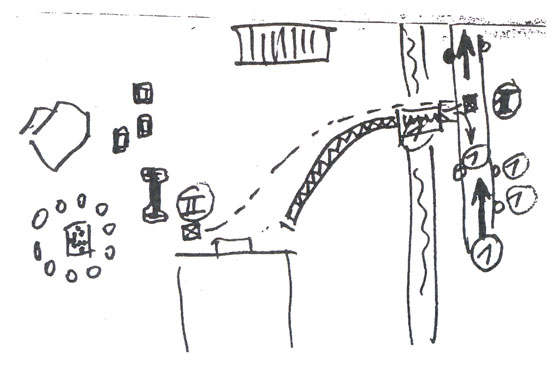In the past:
A stroll through The Art of the ’50s exhibition in Székesfehérvár. Living Realism meets Socialist Realism. Timelessness meets time. The whole meets the part.
In the present:
The clothing exhibition in Szombathely: melancholy contemplation.
The Museum of stonework finds and the textile store room of the Savaria Museum. Zero time - endless time. History of zero duration.
The trans-functioned object as statue vivante at an exhibition at the end of Felvonulási tér. Art–life identity. Statue + statue = statue.
Walk along Felvonulási tér: among people, past the VIP tribune, encounter with Lenin.
Textile Art Symposium, Velem, 1980–81
Competition: Subject, the “expression”
CLOTHES MAKE THE MAN?
People all wear different clothes.
Clothes are the expression of one’s personality.
What happens when this “expression” is unusual, and occurs in an unusual place?
That’s the question I want to see answered by presenting, in a variety of settings, clothes that Cavellini and I made in 1980.
The idea is to film what happens, and (in the next few years) to make a collective film based on my own ideas and the ideas of all the participants. I would donate the photo documentation to the Savaria Museum of Szombathely.
Every real work of art is polysemous; thus, I was perfectly able to transform the ideas I had for works of anti-sculpture into works of anti-textile, thanks to the circumstance that I was invited to take part in the Velem symposium. The word “expression” was a master stroke, for it allowed for the creation of inter-medial works carrying the widest possible range of meanings. I would like to append the following texts to my works:
“CLOTHES MAKE THE MAN” (?)
(Clothes are the expression of man as an idea.)
(The expression illustrates the idea.)
(Clothes illustrate the idea unconsciously.)
DRESS DESIGNING AND VIDEO PROJECT:
the pattern of the statue vivante’s clothing is screen printed for reuse as raw material in a videotape made at the Textile Symposium held in Velem.
The objects of the trans-functioning:
table, bottles, glasses,
road,
tree trunk,
drainpipe, men, women and children.

THE VELEM VIDEO PROJECT:
Location: courtyard, lawn and narrow path.
A group of people – dressed in their own clothes – sits down at the table; they pour themselves drinks from the bottles, drink and chat.
Transformation. (cut)
When they set their glasses down, everyone is dressed in script-printed clothes; they all start walking toward the street down the script-printed path. The script-printed clothes gradually fall off as they walk down the street, leaving a trail behind them. They disappear.
From the opposite direction, another group comes, dressed in their own clothes; they turn onto the narrow script-printed path, and head for the table.
They sit down at the table, pour themselves drinks from the bottles, drink and chat....
(Personal commitment. The individual and history. The cyclic nature of things.)